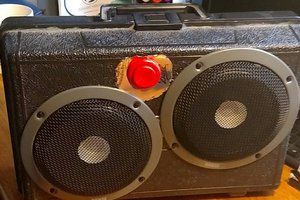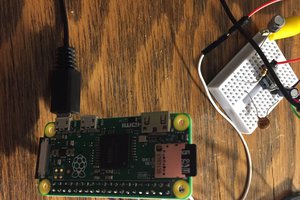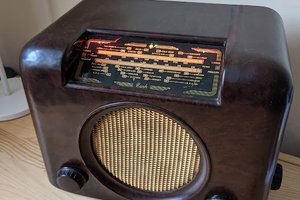I digitized my 8-track cartridges into four channel wav files using the open source Audacity software. To play back four channels of simultaneous audio, I discovered the “Tsunami Super WAV Trigger” sound card which can work on its own or connected to a single board computer or microcontroller. I decided to connect the card to a Raspberry Pi using a serial connection. The Pi also drives the LCD display and reads the button commands via GPIO pins.
Even though the tapes are now digital files, I wanted to preserve the “feel” of the format, so I decided that the device should look and act as much like an 8-track player as possible, but with a modern touch. The cartridges can be inserted into the front via a tape transport removed from an old 8-track player. To sense which 8-track was inserted I added a small QR code to the side of each cartridge. When it is inserted, the amazing “Tiny Code Reader” from Useful Sensors reads the QR code, transmits the data to the Pi over I2C, which then instructs the sound card to play the appropriate file.
Another holdover from the 8-track feature set is the program button. Pressing this button advances the playback to the next track and also lights the appropriate track indicator. (The indicators were also harvested from an old tape deck) In addition, for a realistic sound effect there’s a solenoid that clicks just like the one that would move the head on a real 8-track player.
I used the case from an old Sony AM/FM tuner as the base for my modern player. I removed all of the innards from the tuner and cut out the front control panel so I could 3D print my own custom panel. I also harvested four VU meters from two old 8-track recorders. Surprisingly, there are many different VU meter driver boards available on Amazon. You simply provide power to the boards along with a line level audio signal, and they output a signal that properly drives an analog VU meter. Two blue LEDs behind each meter provide a nice glow.
Power is provided by an outboard 5V/6A power supply that connects to a barrel jack where the AC cord used to be located on the back of the tuner. Everything in the device runs on 5 volts except the meter LEDs, which are powered through a 3V regulator mounted on the power distribution board.
Custom Python code running in a container on balenaOS ties all the hardware pieces together. This code includes functionality for:
- Sensing when any of the six pushbuttons are pressed.
- Updating the LCD display.
- Sending control signals to the sound card.
- Processing data from the QR code reader.
- Illuminating the proper track LED.
- Sensing when a tape is inserted or removed.
- Sensing when the “program” button is pressed.
- Quickly engaging and disengaging the solenoid for sound effects.
 Alan Boris
Alan Boris


 Matthew Gorr
Matthew Gorr
 ehunck
ehunck
 CircuitMonster
CircuitMonster
 Saul Cozens
Saul Cozens
Wow, that brings back memories. 👍 Do you simulate the short hiatus when the "tape" switches tracks or is that already in the digitised file?